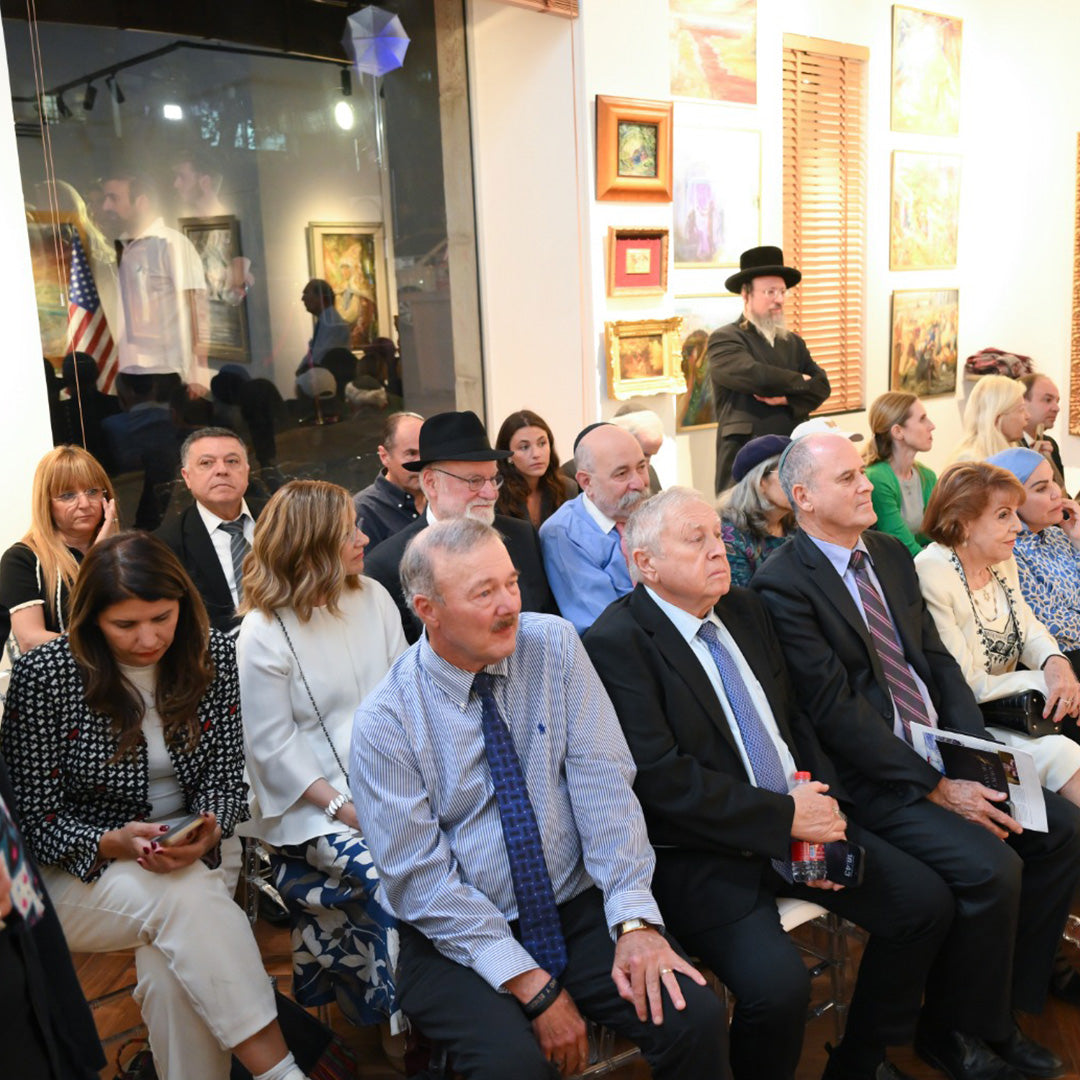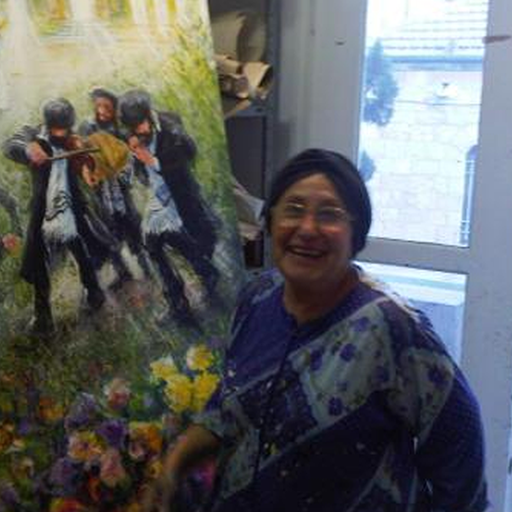From a Modest Apartment in Mea Shearim to Major Exhibitions Worldwide: The Painter Ahava Elisha
She has been painting for as long as she can remember, and over the years became one of Israel’s most renowned painters. At 91, Huvy (Ahava) Elisha still held her brush every day, creating wonders that were exhibited and sold around the world. ‘I feel that God holds my hand and paints through me,’ she said

In a small, modest room, its floor stained with paint and scattered with countless tin cans filled with brushes and colors, 91-year-old Huvy (Ahava) Elisha stands and paints for hours each day. Even before touching the canvas, she already envisions in her mind exactly what will appear upon it. With her works rich in minute detail, brimming with vitality and beauty, she has no need to see the scenes before her in reality — for they live fully within her imagination.
Among her paintings, Jewish weddings and Hasidic dances stand out, as well as landscapes from her childhood in distant England, and biblical stories that, under her brush, are given new life. Despite her advanced age and frail health, she could never give up the craft of painting that so deeply sustains her. Each day, toward midday, after dedicating her morning hours to study and prayer, Huvy enters her studio and paints until evening. Though she rarely leaves her home, breathtaking landscapes and entire worlds of beauty leave her hands each week, traveling to every corner of the world.

Among her paintings, Jewish weddings and Hasidic dances stand out, as well as landscapes from her childhood in distant England, and biblical stories that, under her brush, are given new life. Despite her advanced age and frail health, she could never give up the craft of painting that so deeply sustains her. Each day, toward midday, after dedicating her morning hours to study and prayer, Huvy enters her studio and paints until evening. Though she rarely leaves her home, breathtaking landscapes and entire worlds of beauty leave her hands each week, traveling to every corner of the world.
I meet her in the small living room of her home, which opens onto a large balcony overflowing with flowers. From the floor below rise the sounds of Torah study, in the apartment that once served as her studio and is now devoted to a kollel for scholars. ‘I have been painting for as long as I can remember,’ she tells me. ‘Even as a little girl I painted — even on my mother’s tablecloth, to her dismay, of course. Painting is my way of expressing myself and reaching out to the world. Whenever I wish to wander freely, I simply take a brush and paint whatever I desire.’
She was chosen by international art consultant Nicholas Forrest as one of the ten Israeli artists to watch at auction, and her paintings — displayed at her Jerusalem gallery and in exhibitions worldwide — are sold for tens of thousands of dollars.
Wandering Between Countries
Huvy began her childhood in Jerusalem’s Bukharim quarter, born to a mother who was a nurse and a father who was a businessman, often away for long stretches abroad. “As a child, I remember running away into the fields around the neighborhood, wandering there without anyone knowing,” she recalls. “Sometimes I missed my father, who was rarely at home. When I was six, my parents decided to move to Vienna for his business. But the winds of war soon forced us to leave, and from there we moved to Prague. Two years later, we found ourselves fleeing again — this time to London, where we had relatives. Not long after, the Blitz began, with heavy German bombings, and we relocated once more, to a quiet, picturesque town called Torquay in southwest England.”
As a little girl, she had already lived in four different countries. How did all these moves affect her?
“On one hand, I enjoyed seeing new places and people, and the beauty I discovered around me gave me great delight. On the other hand, when I arrived in England, I spoke German and Czech but didn’t yet understand English, which made it harder to fit in and succeed at school. Moving to Torquay deepened that isolation, and I no longer tried to open up socially. Instead, I enjoyed roaming along the seashore and through the flowering fields. Since I always loved being alone, it never really bothered me and to this day, I most enjoy being in the company of my brush and colors.

In Torquay, Huvy was not a particularly strong student, but she was blessed with a remarkable headmistress who recognized her talent and gave it the space it deserved. “I was terrible at school especially in math. Numbers were never my strong side,” she says with a smile. “Still, the teachers were kind and supportive, and they understood the challenges we faced with all the moves we had gone through. The headmistress, who was herself a painter, saw that I wasn’t succeeding academically and allowed me to sit in a separate room and paint. She loved my work and understood that this was my calling in life. At the age of 14, she recommended to my parents that they enroll me in Saint Martin’s College, a prestigious art and design school in London, instead of continuing with regular studies. She even helped me gain admission, making me the youngest student ever accepted.”
At 17, Huvy married Eli, a rug dealer. “The very night of our engagement, the war ended. I remember driving through the city as music poured from every corner and people danced in the streets. It felt as if all of England was celebrating with us — a night I will never forget. For the next two years, before the children arrived, I painted for hours each day, and in the evenings I would refresh myself by visiting different exhibitions. Once our three children were born, I devoted most of my time to raising them, leaving less for painting. Still, I never stopped entirely. Throughout the years, I always found time for it, and I would regularly present my works in exhibitions.
Longing for Home
Though life in London was comfortable, Huvy never felt it was truly her place. When the opportunity arose to return to the land she felt most deeply connected to, she seized it without hesitation. “At one point, my husband traveled to Tel Aviv on business, and I told him not to move from there — that I was coming to join him,” she recalls. “I never felt a real bond with London, but Jerusalem was always in my heart. On the spot, I booked tickets and, together with our three children, landed in the Land of Israel. We eventually settled in Herzliya Pituach, where we built a home on the seashore, but the dream of Jerusalem remained deeply rooted within me — it just had to wait a few more years.”
At a certain stage, Huvy’s son began drawing close to the Breslov Hasidic movement and organized Torah classes in their home. “We too would sit and listen to the lessons and watch how people were drawn closer through them. In time, our entire family became Breslov Hasidim. I love Rabbi Nachman and his teachings very much they truly speak to me.
 At that point, the time felt right to move to Jerusalem. After years of living in a large home by the sea, the family relocated to a modest apartment in Mea Shearim. “The very first house we saw was the one we bought, and I have lived here ever since,” says Huvy. “This is my true place, and the moment I arrived, I felt myself bloom.”
At that point, the time felt right to move to Jerusalem. After years of living in a large home by the sea, the family relocated to a modest apartment in Mea Shearim. “The very first house we saw was the one we bought, and I have lived here ever since,” says Huvy. “This is my true place, and the moment I arrived, I felt myself bloom.”
As someone who grew up surrounded by wide open spaces and breathtaking landscapes, why choose crowded Mea Shearim?
“I chose to live here because it is the place where I was born and the one I felt most connected to. Beyond that, I no longer need to go out into the open spaces as I did when I was a child. Today, the rivers, clouds, trees, and flowers all exist in my mind. Whenever I feel the need to step into nature, I simply paint them. For me, painting landscapes is like walking into the natural world, and through it I express everything I wish to.”
And what about difficult emotions? Do you express those in your paintings as well?
“I keep the painful emotions to myself, since our world already has enough hardships. I see it as my mission to bring joy to people through my art, not to sadden them. I enjoy painting happy things — landscapes, blossoms, weddings, and dances — so that anyone who sees them will feel uplifted and inspired, and the paintings will give them a good feeling. Only when it came to the horrors of the Holocaust — which I did not experience personally, though many around me did — did I feel such deep pain that I sometimes painted scenes of suffering. But those sorrowful works I never show to anyone.”
One day, a woman named Chania, who owned an art gallery, noticed Huvy on the street carrying a bag of paints. “She asked me if I was a painter. She told me her gallery received many visiting tourists and asked me to create some paintings for her,” Huvy recalls. “That was how my work began to gain wider recognition, until eventually the time came when we opened a gallery dedicated entirely to my paintings.
 A monumental painting depicting the spies returning to Moses from the Land of Israel was recently purchased by U.S. Ambassador to Israel David Friedman for his office at the embassy. He is joined by many others, from Israel and abroad, who proudly adorn their homes with Huvy’s remarkable works. “People come to our gallery from all over the world, and the most astonishing thing is to see visitors from the Far East—who have no prior knowledge of Judaism—purchasing paintings with Jewish elements, as if something within them is touched by it,” says Raphael, Huvy’s son. “One of Indonesia’s great millionaires, nearly elected president, has purchased several of my mother’s works. On another occasion, a Christian priest stood for a long time before one of her paintings a scene even many observant Jews would not immediately recognize. When my brother asked if he knew what the work depicted, he replied, ‘Of course, it is the resting place of the Baal Shem Tov in Medzhybizh.’ To our great astonishment, the priest’s wife explained that not only was he familiar with the Baal Shem Tov, but he even shares teachings from him every Sunday in his sermons.”
A monumental painting depicting the spies returning to Moses from the Land of Israel was recently purchased by U.S. Ambassador to Israel David Friedman for his office at the embassy. He is joined by many others, from Israel and abroad, who proudly adorn their homes with Huvy’s remarkable works. “People come to our gallery from all over the world, and the most astonishing thing is to see visitors from the Far East—who have no prior knowledge of Judaism—purchasing paintings with Jewish elements, as if something within them is touched by it,” says Raphael, Huvy’s son. “One of Indonesia’s great millionaires, nearly elected president, has purchased several of my mother’s works. On another occasion, a Christian priest stood for a long time before one of her paintings a scene even many observant Jews would not immediately recognize. When my brother asked if he knew what the work depicted, he replied, ‘Of course, it is the resting place of the Baal Shem Tov in Medzhybizh.’ To our great astonishment, the priest’s wife explained that not only was he familiar with the Baal Shem Tov, but he even shares teachings from him every Sunday in his sermons.”
It often happens that those who purchase her paintings later come knocking at her door, eager to meet the extraordinary artist behind them. “In the past, even whole groups of students or soldiers would come to hear about my life as a painter and about the process of creating art,” Huvy recalls. “I had more strength to receive them then less so today. But it is always moving to see how deeply the paintings touch people’s hearts, to the point that they feel compelled to meet the person who created them.
 In general, when a person’s work comes from the heart and they truly love it, others can feel that too, and they find meaning in it. You can see even artists who create unconventional works yet people still buy them, because they sense an inner truth there. Personally, I feel that God has given me an extraordinary gift, and that He is the one holding my hand as I paint. I love every painting I create, and I pour my heart and all my emotions into each one. Our world is filled with beauty and color, and I thank God that I was blessed with the ability to cover the canvas with my love for that beauty. Most meaningful of all is the deep satisfaction I feel at being able to bring this beauty into people’s lives and to bring them joy.
In general, when a person’s work comes from the heart and they truly love it, others can feel that too, and they find meaning in it. You can see even artists who create unconventional works yet people still buy them, because they sense an inner truth there. Personally, I feel that God has given me an extraordinary gift, and that He is the one holding my hand as I paint. I love every painting I create, and I pour my heart and all my emotions into each one. Our world is filled with beauty and color, and I thank God that I was blessed with the ability to cover the canvas with my love for that beauty. Most meaningful of all is the deep satisfaction I feel at being able to bring this beauty into people’s lives and to bring them joy.
 source: Hidabroot
source: Hidabroot



Leave a comment
This site is protected by hCaptcha and the hCaptcha Privacy Policy and Terms of Service apply.